Editor of this issue: Violeta Kelertas
Copyright © 2001 LITUANUS Foundation, Inc.

|
LITUANUS
LITHUANIAN QUARTERLY JOURNAL OF ARTS AND SCIENCES
Volume 47, No. 3 - Fall 2001
Editor of this issue: Violeta Kelertas ISSN 0024-5089
Copyright © 2001 LITUANUS Foundation, Inc. |

|
SUBLIMITY AND NATURE: M. K. ČIURLIONIS'S JŪRA
ENRIQUE ALBERTO ARIAS
De Paul University
The present article continues a series of studies on Lithuanian composers and music I have written for Lituanus beginning in the 1980s. The reason for this research was my friendship with Dalia Kučėnas, whom I met in the early 1970s when I was dean of Chicago Conservatory College. Dr. Kučėnas was at that time studying with Tex Richardson (1943-1978), an extraordinarily gifted musician and vocal coach. Because of this connection with Dalia Kučėnas, I became interested in Lithuanian music. This interest became more crucial after the death of Vytas Nakas (1947-1976), a talented young Lithuanian singer and musicologist and close friend of Dalia Kučėnas, who, we both felt, had the necessary linguistic, cultural, and historical background to do significant work on Lithuanian music. His early death sparked a need to continue his work and write the kind of articles he would have written had he lived longer. The present article on M.K. Čiurlionis, the seminal figure in the development of contemporary Lithuanian culture is especially important to me both because of Dalia Kučėnas's death and because its subject matter demonstrates Čiurlionis's connections to Romantic aesthetics and major musical developments at the turn of the 19th and the beginning of the 20th centuries. In conclusion, this article continues my previous work for these pages, but it is also a testament to Dalia Kučėnas, who inspired me and many others to artistic and intellectual efforts.
The Aesthetics of Sublimity
The Romantic period developed innovative ideas regarding nature and sublimity. For the Age of Reason, nature represented an orderly process that regulated the universe in clocklike fashion. Above all, nature was reasonable. When ''art imitated nature," to quote Aristotle's celebrated phrase, it reflected the beauty and supposed order that lay at the heart of nature.
The Romantic period, however, viewed nature quite differently. Nature now implied a terrible and incomprehensible force capable of great destruction. When art of the Romantic period sought to reflect nature, it mirrored its awesome and mysterious energy. Mountains, oceans, and storms, for the Romantics, revealed the true spirit of nature and often functioned as symbols of music, literature, and art.
As Kenneth Clark points out, the European concept of nature changed radically in 1755, when Lisbon was struck by a major earthquake.1 At about the same time, Europeans became acquainted with a treatise ascribed to Longinus entitled On the Sublime (3rd century, A.D.), which, in turn, inspired Edmund Burke's A Philosophical Inquiry into the Origin of our Ideas of the Sublime and Beautiful (1757).
Burke defines sublimity as follows: "Whatever is fitted in any sort to excite the ideas of pain, and danger, that is to say, whatever is in any sort terrible, or is conversant about terrible objects in a manner analogous to terror, is a source of the sublime; that is, it is productive of the strongest emotions which the mind is capable of feeling."2
Certain natural objects inspire a sense of sublimity: "A level plain of a vast extent on land is certainly no mean idea: the prospect of such a plain may be as extensive as a prospect of the ocean; but can it ever fill the mind with anything so great as the ocean itself? This is owing to several causes, but it is owing to none more than this, that the ocean is an object of no small terror."3 After examining many features of the topic, Burke finds that sublimity is essentially a reflection of the divine nature.
Jean Jacques Rousseau, as Kenneth Clark notes, also explored new concepts about nature. Indeed, Clark sees Rousseau as the central figure in this radical shift, for "it was among the lakes and Alpine valleys of Switzerland that his absorption in nature first became a sort of mystical experience."4 Burke and Rousseau held that sublimity transcended beauty, which results from the contemplation of order and tranquility, sublimity, on the other hand, is an emotional response to the totality of nature. Ultimately, it is through the experience of sublimity that one discovers God, and it is this philosophic basis that becomes the touchstone for 19th-century Romanticism.
Depictions of Nature in Music
These provocative changes in aesthetics influenced composers as well. In the 18th century, composers depicted a serene and orderly nature. Vivaldi's celebrated concert! The Four Seasons (c. 1725) or Haydn's impressive trilogy of symphonies Nos. 6-8, Morning-Afternoon-Evening (1761) are magnificent examples of this view of nature. On the other hand, the composers of the 19th century depicted nature more immediately and dramatically. More than any other work, Beethoven's Symphony No. 6 (Pastoral) (1808), with its scene by the brook and thunderstorm leading to a hymn of thanksgiving to God, provided a powerful model to later composers. Other composers of the Romantic period created musical depictions of the vastness and power of nature. For example, Liszt's tone poem Ce qu'on entend sur la Montagne (1849), based on Victor Hugo, partly resulted from the composer's personal experience of the Alps.
Increasingly, the sea serves as a symbol and source of inspiration for composers of later Romanticism.5 At the turn of the last century, Debussy's La Mer (1905) and M.K. Čiurlionis's Jūra (1903-07) both powerfully and evocatively depict the sea. Although conceived at the same time and employing a common source of inspiration, these two orchestral works were written independently of each other and exhibit dramatically different styles. The present study examines Čiurlionis's major orchestral work Jūra in the context of the Romantic aesthetics and musical development I have just described. Although Jūra is independent of Debussy's La Mer, I will show it is influenced by the tone poems of Richard Strauss, particularly Also sprach Zarathustra (1896), which served as a principal model.
The Tone Poem during the Romantic Period
During the 19th century, Franz Liszt evolved the tone poem into a major form of orchestral expression. Subjects from history, mythology, and literature dominate these works, as illustrated by Tasso (1849), Mazeppa (1851), and Orpheus (1854). By the end of the Romantic period, tone poems increasingly turned to nature for inspiration, as exemplified by Biedrich Smetana's Má Vlast (1872-75).
The major composer of tone poems at the end of the Romantic period was Richard Strauss, who expanded Liszt's model of the tone poem together with orchestral and harmonic techniques found in the operas of Richard Wagner. Strauss's tone poems were considered at the end of the 19th century to be daring adventures in musical modernism, with their frequent. dissonances, chromaticism, and complex polyphony. Strauss's tone poems reach a climax in several extensive works, such as Also sprach Zarathustra (1896), based on the philosophic work by Nietzsche, and Bin Heldenleben (1898), which has subtle autobiographical elements. As I will later point out, these majestic tone poems, but particularly Zarathustra, inspired Čiurlionis's Jūra.
The Biography of M.K. Čiurlionis
Since the biography of Čiurlionis has been frequently presented by Lithuanian authors, I will highlight only those aspects that bear on the composition of Jūra.6 Born 22 September 1875 in Varėna, Lithuania, Čiurlionis was the son of an organist, who was also his first teacher. In 1889, he was accepted into the orchestral school of Michael Oginski, where he studied flute, winds, played in the orchestra, and began composition lessons. This was to be the formative experience in Čiurlionis's life, and Oginski would remain an important mentor. He studied in Warsaw from 1894 to 1899, working with A. Sygietynski in piano and Z. Noskowski in composition. He also studied theory and history, thus becoming familiar with the German repertory. Summers were spent in Druskininkai, where he deepened his study of the folkloric, a major influence on Čiurlionis.
In 1901, at the suggestion of Oginski, he went to the Leipzig Conservatory, where he studied theory and composition with Karl Reinecke and Salomon Jadassohn. Here he began composing in large forms and participating in Leipzig's rich cultural life. Of special importance was his attendance at the orchestral concerts of the Gewandhaus, where he heard Artur Nikish conduct. Nikish was one of the most imposing conductors of the period and closely associated with the Wagner-Strauss tradition. Čiurlionis also became interested in opera and studied the scores of Hector Berlioz and Richard Strauss in the library.7 He graduated in 1902, having become fascinated with the innovations of Strauss and evolving a personal musical philosophy. It was in Leipzig that Čiurlionis first became aware of the philosophy of Friedrich Nietzsche, which was to dominate his thinking for the rest of his life.
After graduation, Čiurlionis returned to Warsaw, and then, in 1907, to Vilnius in order to organize musical activities and structure major Lithuanian musical institutions. Frustrated by a lack of recognition, he moved to St. Petersburg in 1919, where he had previously participated in the Diaghilev exhibitions called "the World of Art" (1908-1911). In 1909, he contracted an illness, which led to his death at the Czerwony Dwor Sanatorium near Warsaw. He was then buried in Vilnius.
Čiurlionis's short career can be divided into two parts: the first emphasizing composition, the second, after 1907, devoted to art. Throughout his life, Čiurlionis studied Lithuanian folklore and music. Widely read in philosophy and influenced by Eastern thought, Čiurlionis sought a syncretism based on his extensive studies and experiences.
Čiurlionis's compositions exhibit chromaticism and expanded tonality. Increasingly the piano preludes, perhaps his most characteristic works, are controlled by unified motivic and chordal structures. He has been compared to Scriabin, but the works of Richard Strauss and, I believe, Max Reger, had a more profound impact. Of his many compositions the orchestral tone poem Jūra is significant because of its length, rich texture, and beautiful handling of thematic transformation.
Jūra: Composition and Analysis
Jūra was composed between 1903 and 1907 and is dedicated to his Warsaw friend and protectress, Mrs. B. Wolman. On a visit to the Wolman summer home in the Crimea, Čiurlionis first saw the Black Sea. This was the first time he experienced a sea other than the Baltic, and he was overwhelmed by its vastness. This must have been the original inspiration for Jūra, for the sea became a symbol for Čiurlionis of the "eternal becoming."8 Jūra was first performed in 1936 in Kaunas on the occasion of the 25th anniversary of the composer's death. Čiurlionis wrote to his fiancée, "I want to compose a symphony from out of rolling waves, the mysterious talk of the woods, the twinkling of stars, of our old songs, and my boundless longing,"9
In 1990, on the 115th anniversary of Čiurlionis's death, the original version was premiered. In the period 1936 to 1990, the work was only known in an edition by Eduardas Balsys. The original version, which restores the work's length and orchestral richness, was recorded by Gintaras Rinkevičius in 1992.10 Jūra's length and complex style suggest that the composer viewed this tone poem as his entree as a major composer, but it also summarizes his philosophic and musical thinking up to 1907. That it was not performed during his lifetime must have been a major disappointment. Jūra is scored for the full Romantic orchestra, including a full contingent of brass and harp. Significantly, like Strauss's Zarathustra, it includes an organ part at the major climaxes and, as I will show, it is Strauss's Zarathustra, that inspired Jūra.11 Nietzsche's Zarathustra, published in 1893 and widely read by all European intellectuals soon thereafter, probably impressed Čiurlionis as much as it had Strauss. This the reading of Nietzsche, together with the sight of the Black Sea and the study of Strauss's tone poems, probably inspired Jūra.
Strauss's tone poem is indicated as freely after Nietzsche." Although Strauss did not want this work to be considered "philosophical music," and ordered the tone poem's episodes differently from that of the Nietzsche original, the tone poem is strongly related to Nietzsche's great poetic meditation. It is also possible that Čiurlionis wrote Jūra as much under the spell of Nietzsche as of Strauss.
Jūra is conceived in large overlapping sections, with the greatest rhythmic activity occurring toward the middle of the work. The conclusion gradually returns to the thematic material of the opening, but transformed through varied orchestration. The vastness of the sea is depicted not only in the general dimensions of the work but in many of the ostinato motives and wavelike thematic ideas. Čiurlionis often creates large climaxes, which elide into the next section, to convey the sense of immense power. Modal harmonies and the quotation of the Lithuanian folksong Močiute mano create the aura of the folkloric and hymn-like.
Jūra begins with an ascending E major scale; in the harp followed by an ostinato motive based on the descending intervals of the fifth and fourth, first heard in the flute. (Ex. 1) This opening scale passage establishes a gesturelike a rushing wavethat is frequently varied and repeated throughout. The ostinato, which gradually moves to the lower parts of the orchestra, controls much of the work's thematic process and conveys the gentle rocking of the sea. This musical idea is derived from the opening of Strauss's Zarathustra, also based on the interval of the fifth announced by the trumpets followed by the timpani. Čiurlionis must have been dazzled by the beginning of Strauss's score, for it is clearly mirrored at the beginning of Jūra. (Ex. 2) In turn, Strauss was inspired by the opening of Nietzsche's great philosophic poem.12
The prolonged ostinato moves to a hymn-like section in the full orchestra, which has modal implications similar to the opening of Zarathustra. A diminution of the ostinato and a descending chromatic sequencealso a constant in the workfollow. Sustained figurations in the upper strings and multiple layers of melodic activity, anchored by the ostinato, also generally reflect the opening of Zarathustra. This section concludes with the flute emphasizing the ostinato of the fifth.
The next section is more animated and fluctuating in tonality. (Ex. 3) The harp is here given prominence, another reflection of Strauss. Varied references to motives from the first -section are allied to chromaticism in descending sequence. In addition, the energy of the sea is captured in undulating patterns against more sustained chords in the brass and horns. Extensive climaxes, sometimes with evaded cadences, further give the illusion of ongoing motion. One of the most important aspects of this section is the entry of the organ to underline the hymn-like climax.
A central section in C major and 6/8 meter has a rocking pattern that is derived from the opening emphasis on the interval of the fifth. A solo passage for the violin outlining the work's kernel interval of the fifth provides further unity. (Ex. 4)
The introduction of a melody in parallel thirds in the upper strings toward the end of the central section also reflects the influence of Strauss. (Ex. 5) This section is quite similar to the "Das Tanzlied" episode of Strauss's Zarathustra, where a solo violin is heard in a bittersweet waltz melody. Čiurlionis has imitated Strausian lyricism, the use of the upper register of the violins, and the broad melodic gestures, often ending with the descending interval of the seventh. On the other hand, Čiurlionis has transformed these elements in such a way that this reflection of the Strauss tone poem is part of a subtle counterpoint of motives.
Jūra's broad conclusion is related to the work's opening, one hears a further emphasis on the organ and solo violin in polyphony that includes the descending chromatic sequence and references to the kernel motive of the fifth. The extraordinary orchestration, with harp against the lower winds and contrabassoon, is also reminiscent of Strauss. As one nears the work's conclusion the opening texture and the E major tonality return, with the principal ideas blending into each other creating a subtle arch form in the general design. An extended pedal tone on E provides tonal affirmation. A thick contrapuntal texture and expanded cadences create the Straussian apotheosis, which highlights the shift from E to C that is present in the work's macro-structure. (Ex. 6)
The general image of the sea is musically captured by numerous features of the score. Some of these are: the slow ostinato of the fifth and fourth, the wave-like scale passages in the central section, the overlapping lines in the various parts of the orchestra, the leisurely pacing of the general structure, and the oscillating tempi. Instead of clear-cut alterations of tempi, Čiurlionis prefers subtle rubato-like tempo modifications based on texture and thematic material. The influence of Strauss is likewise evident in a preference for obscure articulations between phrases and sections.
The following summarizes the common elements between Zarathustra and Jūra:
The inclusion of the organ for color and the support of climaxes.
The interval of the fourth and fifth for musical and symbolic reasons.
An episode similar to "Das Tanzlied" of Zarathustra.
A common inspiration in late Romantic aesthetics, with a particular affirmation of Nietzschean sublimity.
Čiurlionis on Music
Čiurlionis's treatise on music, Apie muziką ir dailę (1904), conceived while Čiurlionis was composing Jūra, also relates Čiurlionis to Strauss. As Dorothee Eberlein points out, this treatise was written during his Warsaw years when he was beginning his concentration on art and becoming more aware of himself as a Lithuanian rather than a European creator.13 Bach, Beethoven, Mozart, Schubert, Schumann, Wagner, and Richard Strauss are cited for their German profundity, controlled forms, and powerful sentiment. Lithuanian folk music is compared to the monotony of the sea; thus Jūra relates to Čiurlionis's concept of Lithuanian folk music in general. Ultimately, Čiurlionis sees music as "the speech of God," born at the same time as the soul of man and his first attempts at language. In many ways, Jura exemplifies the treatise's philosophic principals, principals clearly influenced by German idealism in general and by Nietzsche in particular.
Čiurlionis and Debussy
It is tempting to see connections between Čiurlionis's Jūra (1903-07) and Debussy's La Mer (1905). Although these two orchestral works were composed at the same time and on the same general subject, Čiurlionis began his tone poem before the premiere of La Mer. Furthermore, Čiurlionis would have had little opportunity to have heard Debussy's music, which was not well known in Germany or Poland at the beginning of the 20th century. The common inspiration can, I believe, be traced back to the image of the sea as a symbol of sublimity, for both Debussy and Čiurlionis were aware of Romantic aesthetics and reacted in personal ways.
More specifically, Debussy was influenced by the sea paintings of William Turner, which were shown in Paris in 1894. Debussy again saw these paintings at the 1902-03 Turner exhibition at London's National gallery. Čiurlionis was also aware of Turner's turbulent and magnificent depictions of the sea, which had caused a sensation throughout Europe and which epitomized the English tradition of sublimity.14
Nonetheless, there are some fascinating similarities between these two orchestral works. Both fall into contrasting sections to depict the different moods of the sea and both use the orchestra evocatively. Debussy, in this regard, subtitled his work "three symphonic sketches" in order to highlight its pictorial quality. The majestic conclusion of La Mer is similar to several hymn-like passages in Jura. In addition, Debussy's delicate handling of solo instruments recalls Čiurlionis's emphasis on the flute, harp, and bass clarinet, at key spots in his score. On the other hand, the strongly impressionistic treatment of motives and chord progressions sets La Mer apart. La Mer is clearly in the French tradition, while Jūra is German in its orientation.
In conclusion, Jūra, Čiurlionis's orchestral masterpiece, was inspired by Strauss's Zarathustra. Written at the same time as Debussy's La Mer, it was independently conceived but, tragically, not performed during the composer's lifetime. Ultimately, Jūra was inspired by the Romantic conception of sublimity in nature that can be traced back to Edmund Burke and Jean Jacques Rousseau. It was an astonishing accomplishment for a young composer, a composer who wished to address European audiences at the highest level and with the largest works, but who was fated to receive insufficient attention during his brief lifetime. It is only in the last several decades that Čiurlionis has been recognized as one of the great musical prophets of the 20th century, and now it is time to fully acknowledge the importance of his great orchestral work, Jūra.
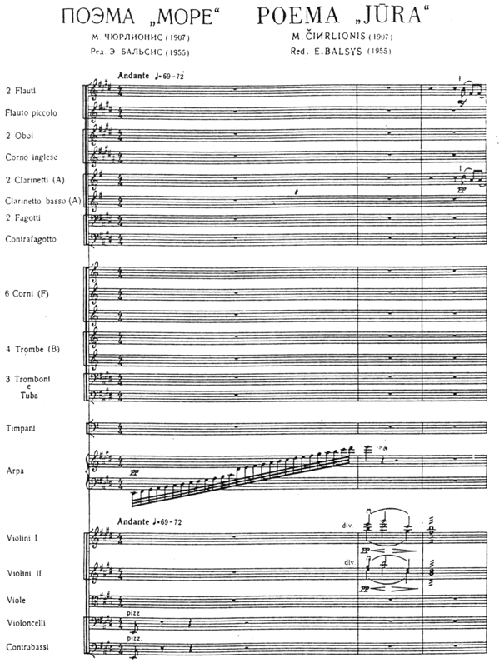
Example 1
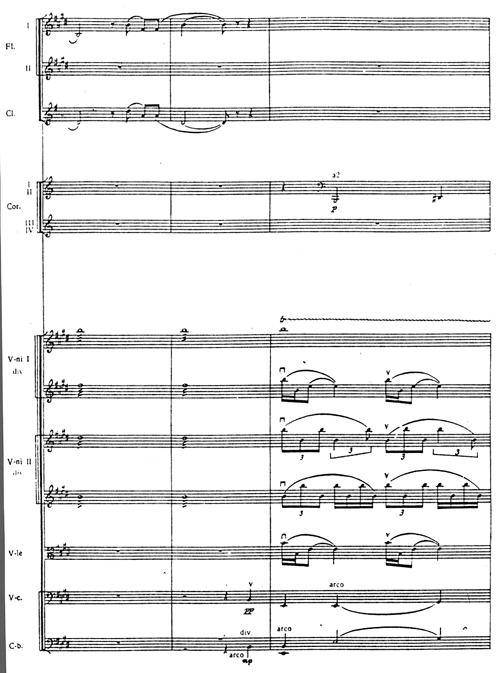
Example 1 (continued)
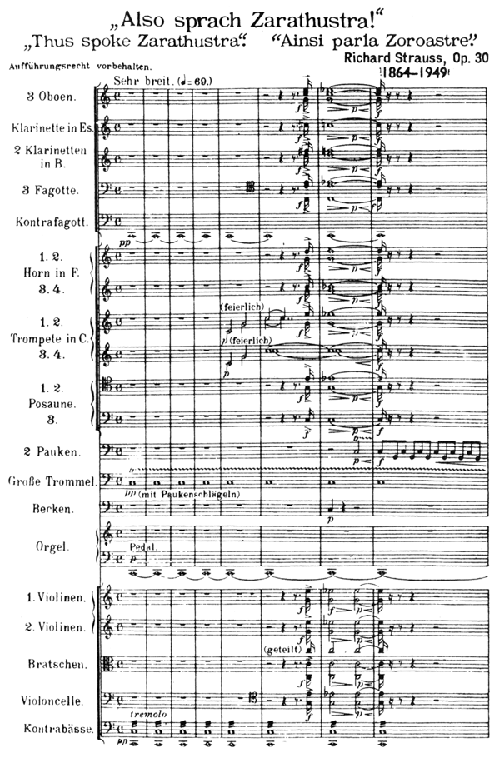
Example 2
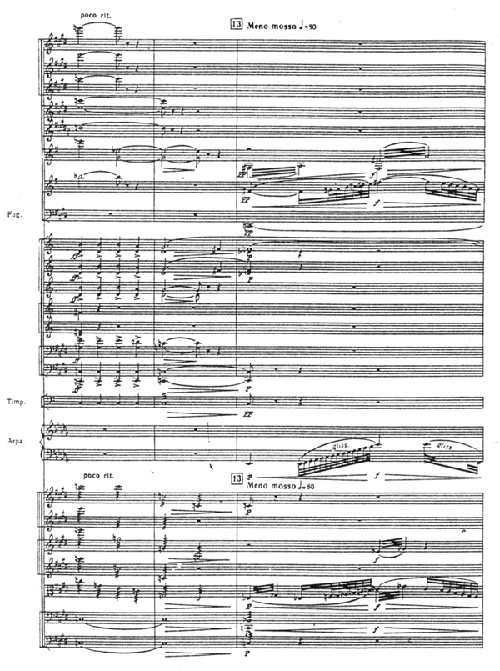
Example 3
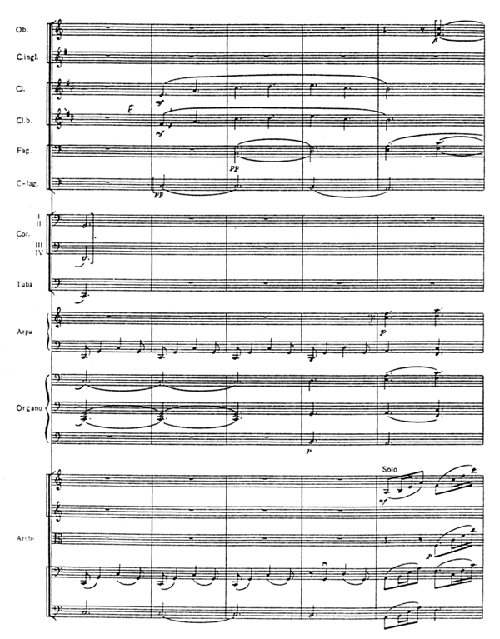
Example 4
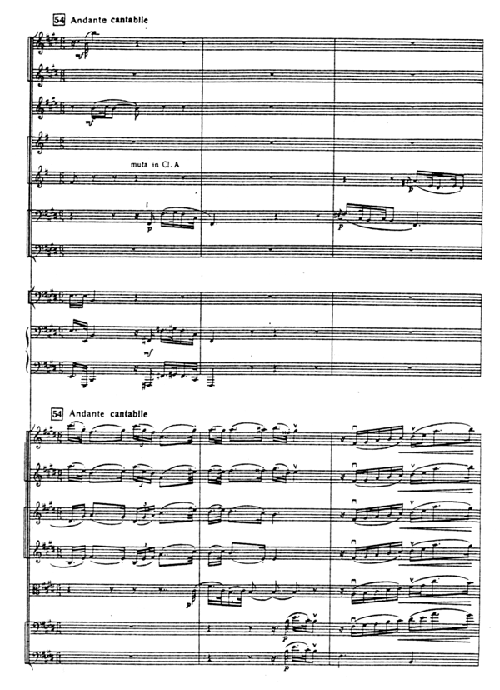
Example 5
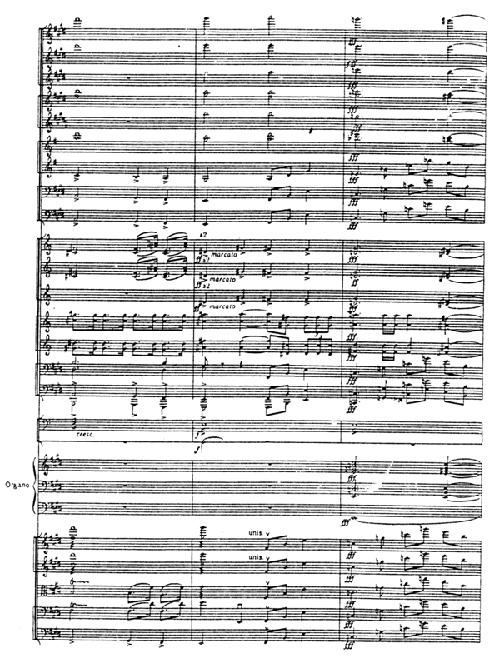
Example 6 (Continued)
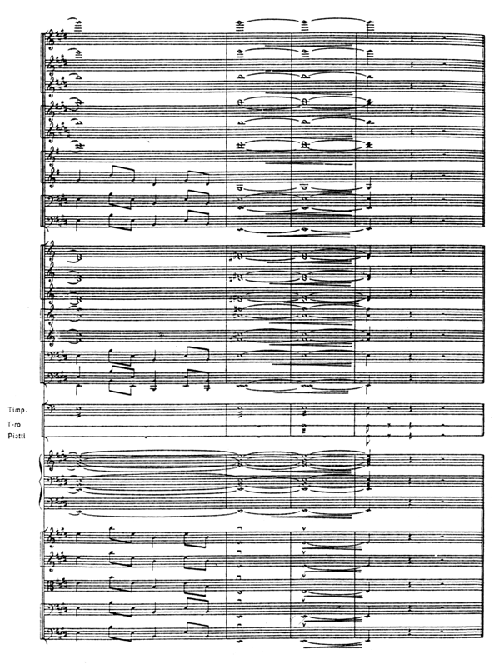
Example 6
1 Kenneth Clark, The Romantic Rebellion (New York: Harper & Row, 1973), 45.
2 Edmund Burke, A Philosophical Inquiry into the Sublime and Beautiful (New York: Viking Press, 1999), 39.
3 Burke, 58.
4 Kenneth Clark, Civilization: A Personal View (New York: Harper &Roe, 1969), 271.
5
Major "sea" pieces from the Romantic period are: Mendelssohn's overture Calm Sea and Prosperous Voyage (1828), based on a poem by Goethe, and his overture The Hebrides: Fingal's Cave (1830); Anton Rubinstein's Symphony No. 2 (The Ocean) (1851-80); and Ralph Vaughan William's Symphony No. 1 (The Sea) (1909), based on the poetry of Walt Whitman. Čiurlionis would probably have known Mendelssohn's two overtures and could have been acquainted with Rubinstein's masterpiece, which was sometimes performed in Russia.
6
The sources for this brief biography are: Nikola] Worobiow, M.K. Čiurlionis: Der Litauische Maler und Musiker (Kaunas: Pribačis, 1938); Antanas
Venclova, Mikalojus Konstantinas Čiurlionis: 32 Reproductions (Vilnius: Valstybinė Grožinės Literatūros
Leidykla, 1961); Lionginas Šepetys, Mikalojus Konstantinas Čiurlionis (Vilnius:
Vaga, 1984); Dorothee Eberlein, "Mikolajus Konstantinus Čiurlionis: Zur 100. Wiederkehr seines
Geburtstages," Österreiche Musikzeitchrift 30 (1975): 649-52.
7 Vytautas Landsbergis, "Das Königliche Konservatorium zu
Leipzig mit den Augen eines Studenten. Briefe von M.K. Čiurlionis," Beiträge
zur Musikwissenschaft 21 (1979), 58. Landsbergis notes that Čiurlionis
copied Strauss's Tod und Verklärung and Ein Heldenleben by hand
for his friend E. Morawski.
8
Jūra was followed by two other artistic creations inspired by the sea: the triptych The Sonata of the Sea (1908) and its musical counterpart Marios for piano (1908). See Lutz
Lesle, "Meersonate und Tannenbaumfuge: Der litauische Maler-Musiker Mikolajus Konstantinas Čiurlionis," Neue Zeitschrift
für Musik 154, no. 6 (1993): 24-29.
9 Liner notes by Vytautas Landsbergis for Mikalojus Konstantinas
Čiurlionis Symphonic Poems, King Records, KICC 76.
10
See footnote 8.
11
Camille Saint-Saëns uses the organ to create magnificent
climaxes in his Symphony No. 3 (1886). Likewise, Scriabin's The Poem of Ecstasy
(1908) employs the organ to complement the
orchestra.
12 Friedrich Nietzsche, Also sprach Zarathustra (New York: Viking, 1999).
13 Dorothee Eberlein, "Čiurlionis, Przybyszewski und Vjacelav Ivanov
über die Musik um 1900," Acta Universitatis Stockholmiensis 5 (1990): 666.
14
Lesle, op. cit.